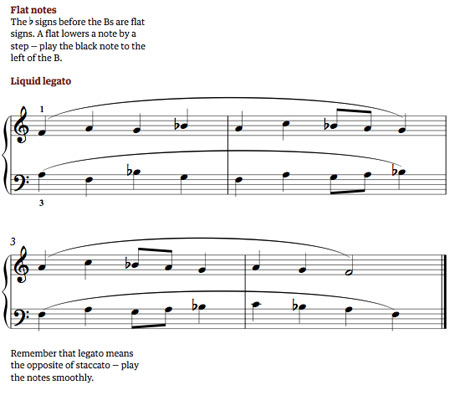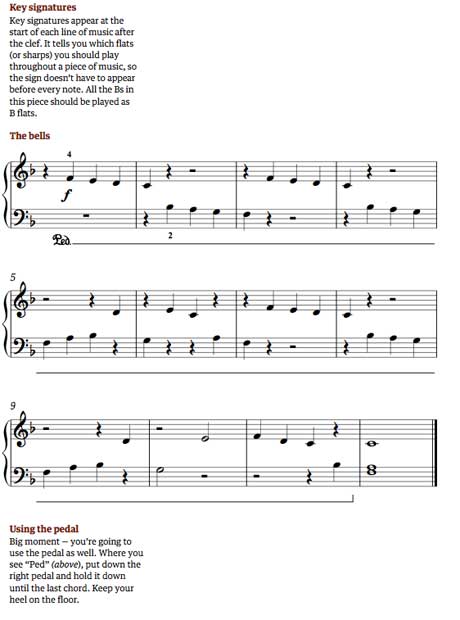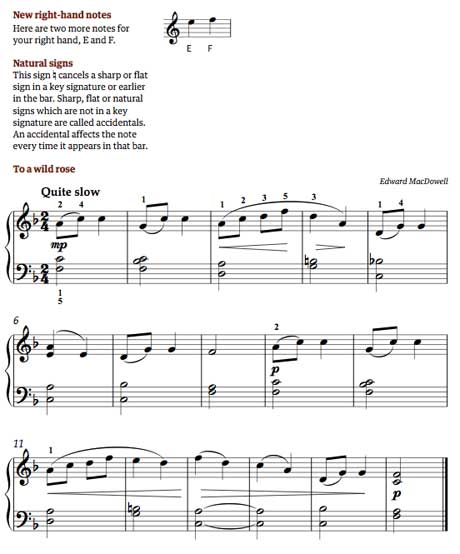from http://www.symbianize.com/showthread.php?t=78637
Interesting Facts About the Piano and Piano Music
especially if you're doing piano research
Did you know that:
Christie's Auction House recently sold a Victorian Steinway grand piano for $1.2 MILLION DOLLARS! The piano was sold to the Sterling and Francine Clark Art Institute of Williamstown, Massachusetts.
What famous piano company was Engelhard Steinweg the founder of?
Maybe this will help. In 1850 he Americanized his name to Henry E. Steinway!
1997 was the 200th Anniversary of his famous Steinway Pianos!
That the piano is known as "The King of Instruments"? The piano earned this title for a number of reasons including it's tonal range ( the piano covers the full spectrum of any instrument in the orchestra from below the lowest note of the double bassoon to above the top note of the piccolo), it's ability to produce melody and accompaniment at the same time (try that on a flute) and it's broad dynamic range. It is also the largest musical instrument (excluding the pipe organ), most versatile and one of the most interesting.
That the average medium size piano has about 230 strings, each string having about 165 pounds of tension, with the combined pull of all strings equaling approximately eighteen tons !
The total string tension in a concert grand is close to Thirty Tons!
That a boxed model D Steinway Grand Piano weighs 1400 Pounds !
That six Steinways are now in the Smithsonian collection.
The working section of the piano is called the action. There are about 7500 parts here, all playing a role in sending the hammers against the strings when keys are struck.
A new piano should be tuned four times the first year, with the change of seasons, and at least twice a year after that.
There are over 10 MILLION pianos in American homes, businesses, and institutions.
The first practical piano with an escapement mechanism for the hammers and capable of being played softly and loudly was built in 1700 by an Italian, Bartolomeo Cristofori (1655-1731).
The Smithsonian in Washington, DC is celebrating the 300th anniversary of the piano with a wonderful exhibit that runs through March 2001. For more information.
Cristofori made few pianos, his attention was to the building of harpsichords.
The name piano is an abbreviation of Cristofori's original name for the instrument: piano et forte or soft and loud.
Spinet pianos were made by Samuel Blythe as early as 1789 at Salem, Mass.
The term Grand was first used in 1777.
Abraham Lincoln used Chickering Grand #5070 while at the White House.
During 1869 the US produced 25,000 pianos valued at $7,000,000, during 1910 production was 350,000 pianos valued at $100,000,000 !
The term "Tickle the Ivories" refers to playing the ivory keys of the piano, however, ivory has not been used to make piano keys since about the 1950's (they are plastic, sometimes referred to as "Ivorine").
That there are currently over 50 Brand Names of pianos?
During the past 100 years there have been approximately 5000 Brands of pianos placed on the market. Most are still on display in homes or elsewhere.
Pianos are made of thousands of pieces of wood glued together to form various parts of the playing mechanism as well as the cabinet. Felt, buckskin, paper, steel, iron, copper, and other materials are also used.
Independent studies show that children who learn piano tend to do better in school. This is attributed to the discipline, eye-hand coordination, social skills building, learning a new language (music) and the pleasure derived from making your own music.
It should also be noted here that anyone considering a career in any facet of music should consider studying the piano . Many music schools require at least one semester of piano, regardless of your major.
Over the years there have been many attempts at "improving" the piano. One such experiment was to replace some of the wooden action parts with plastic. It didn't work, they cracked with age. (If you own one of these pianos, you might want to check out Piano Tuners to get it repaired or even Piano Dealers to replace it). There were many other ideas that tried and failed including the Jensen piano which had 2 keyboards, a vertical grand, one that had a keyboard that was more like a typewriter and many others.
"You can tune a piano, but you can't tuna fish"
Answer: Sure you can, you just adjust it's scales!
Presidential Pianos
1st President - George Washington - Longman & Broderip Harpsichord; Schoen & Vinsen Pianoforte
2nd President - John Adams - Currier & Co.
3rd President - Thomas Jefferson - Astor Pianoforte
4th President - James Madison - Square Grand (name destroyed by fire)
5th President - James Monroe - Astor Piano
6th President - John Quincy Adams - Currier & Co.
7th President - Andrew Jackson - T. Gilbert & Co. Square Piano
8th President - Martin Van Buren - Hallet & Cumston Square Piano
9th President - William Henry Harrison - Haines Brothers
10th President - John Tyler - Thomas Tomkinson Upright Piano
11th President - James Knox Polk - Astor & Harwood Square Piano
12th President - Zachary Taylor - name unknown
13th President - Millard Fillmore - name unknown
14th President - Franklin Pierce - Chickering Square Piano
15th President - James Buchanan - Chickering Grand Piano
16th President - Abraham Lincoln - Chickering Square Piano & Chickering Upright
17th President - Andrew Johnson - Steinway & Sons Square Piano
18th President - Ulysses S. Grant - Melodeon
19th President - Rutherford B. Hayes - Bradbury Upright & Harpsichord (name destroyed by fire)
20th President - James A. Garfield - Hallet & Davis Upright
21st President - Chester A. Arthur - Piano cannot be located.
22nd President - Grover Cleveland - Combination Piano & Harpsichord (name destroyed by fire)
23rd President - Benjamin Harrison - J. & C. Fischer Upright Piano, Haines Brothers Square
24th President - Grover Cleveland - (same as above)
25th President - William McKinley - A. H. Gale Co. Square Piano
26th President - Theodore Roosevelt - Chickering Upright, Steinway Grand Piano
27th President - William Howard Taft - Baldwin Grand Piano
28th President - Woodrow Wilson - Ernst Rosenkranst Square Piano, Knabe Grand
29th President - Warren G. Harding - A. B. Chase Electric Player Piano
30th President - Calvin Coolidge - Sohmer Upright Piano
31st President - Herbert Hoover - Knabe Grand & A. B. Chase Grand
32nd President - Franklin D. Roosevelt - Hardman Grand
33rd President - Harry S. Truman - Steinway Grand, Baldwin Grand & Steinway Upright
34th President - Dwight D. Eisenhower - Hallet & Cumston Upright
35th President - John F. Kennedy - Ivers & Pond Grand Piano
36th President - Lyndon B. Johnson - Style L. Steinway, Knabe Console
37th President - Richard M. Nixon - Geo. P. Bent Upright, Baldwin Vertical
38th President - Gerald Ford - No personal piano
39th President - James (Jimmy) Carter - Ludden & Bates
40th President - Ronald Reagan - Steinway Grand
41st President - George Bush - Did not own personal piano.
42nd President - William (Bill) Clinton - Baldwin Grand in the Governor's Mansion.
Jonas Chickering was the first exporter of American made pianos. First shipment to India 1844.
Yamaha, established in 1887 was the first piano manufacturer in Japan.
That pianos were the first meaningful brand names, the first Status Symbol, and the first major items sold on an installment basis, which was the cornerstone of several major banking institutions of today.
A grand piano action is faster than a vertical (spinet, console, upright) because it has a repetition lever. This allows the pianist to repeat the note when it is only half way up. A vertical action requires letting the key all the way up to reset the hammer action.
Piano Sizes
Concert Grand - 8' 11" and larger
Half Concert Grand - 7'4"
Parlour Grand 6'8"
Drawing Room Grand - 6'4"
Professional Grand - 6'
Living Room Grand - 5'10"
Baby Grand - 5'8"
Upright - 51" and up
Vertical - 36" - 51"
Studio - 44" or taller
Console to 42"
Spinet - 36" to 38"
The worlds largest piano is a Challen Concert Grand. This piano is 11 feet long, has a total string tension of over 30 tons and weighs more than a ton !!
The term A-440 concert pitch refers to A above middle C vibrating at 440 cycles per second.
The first note (on a standard 88 note keyboard) is A .
The exact middle of the keyboard is not middle C, it is actually the space between E and F above "middle" C.
The last note of the keyboard is C.
The Bösendorfer Imperial concert grand piano is 9' 6" long and has 9 extra keys stretching to a growling C below bottom C ! (The Imperial grand sold for $55,000 in 1980!) The 9' and 7' 4" grands have four extra bass keys, the lowest of which is F below bottom C.
Comma (or coma) -- A minute interval or difference in the pitches of the same musical tone occasioned by different systems of tuning. The comma of Didymus is an interval such as that between two enharmonically equivalent notes like B-sharp and C-natural, an amount of 24 cents. (cents are 1/100th of a semitone) The syntonic comma is the interval between a just major third (5:4) and a Pythagorean third (81:84). The comma of Pythagoras (known also as the ditonic comma) is the difference between a cycle of just fifths and seven perfect octaves. In equal temperament tuning this comma is absorbed by the diminishing of each successive fifth in the cycle by the amount of 1/12th of the comma.
Paul Janko, Austria, constructed a keyboard of six tiers, one above the other -- runs and arpeggios made less difficult than on regular piano keyboard.
Zumpe created the square piano in England in 1760.
Beethoven's Studio Piano is in the National Museum, Vienna, Austria.
The first patent issued to H. Steinway, New York, was May 5, 1857.
G. Hoffman built a symmetrically rounded piano in 1804.
M. Welte and Son of Freiburg, Germany and Ludwig Hupfeld introduced the reproducing pianos about 1904.
Sebastian Erard made the first French Square piano in 1777 and the first grand in 1796.
John Broadwood enlarged the strings in the square piano, used two thick strings instead of three thinner ones and moved the wrest plank from the right side to the bottom of the case in 1788.
Johann Christian Schleip built many vertical pianos known as the "Giraffe Piano".
Johann Behrent built the first piano in America at Philadelphia in 1775 under the name "Piano Forte".
Mangeot of Paris built a piano with reversible keyboards in 1876.
Sebastian Erard built a piano and organ combined for Marie Antoinette.
Piano Row was located on 14th Street, New York. This was the headquarters of such fine pianos as Steinway, Steck, Behning, Bradbury, Sohmer and many others.
Nickelodeon is a general term used to describe various electrical coin operated pianos.
The first census giving figures for instrument makers was in 1860 which was 223 - about 110 were piano manufacturers.
About 1870 Daniel F. Beatty advertised rosewood square grands for $255.
Piano player was developed 1863 with push up cabinet, with wooden felt covered fingers that depressed keys. R.W. Pain was probably the first to build a pneumatic self playing piano, a 39 note self contained player for Needham & Sons in 1880.
J.C. Stoddard, Worcester, Massachusetts, invented the Calliope in 1855.
A drop of 1/2 step in pitch can equal a change of 3000 to 5000 Pounds of tension! (Now you know why it is important to keep your piano tuned).












